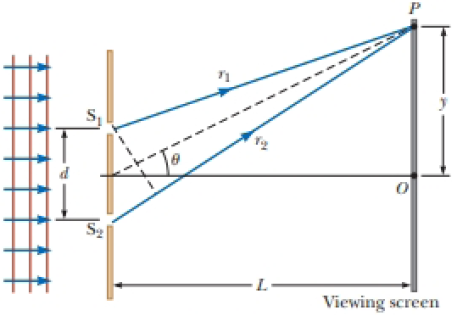
Concept explainers
In Figure P36.10 (not to scale), let L = 1.20 m and d = 0.120 mm and assume the slit system is illuminated with monochromatic 500-nm light. Calculate the phase difference between the two wave fronts arriving at P when (a) θ = 0.500° and (b) y = 5.00 mm. (c) What is the value of θ for which the phase difference is 0.333 rad? (d) What is the value of θ for which the path difference is λ/4?
Figure P36.10

(a)
Answer to Problem 37.18P
Explanation of Solution
Given info: The separation between the slits is
The given diagram is shown below.

Figure 1
The formula to calculate the phase difference is,
Here,
Substitute
Conclusion:
Therefore, the phase difference between the two waves fronts arriving at
(b)
Answer to Problem 37.18P
Explanation of Solution
Given info: The separation between the slits is
The formula to calculate the phase difference is,
Here,
From the right angle triangle
Here,
Substitute
Substitute
Conclusion:
Therefore, the phase difference between the two waves fronts arriving at
(c)
Answer to Problem 37.18P
Explanation of Solution
Given info: The separation between the slits is
The formula to calculate the phase difference is,
Here,
Rearrange the above formula to find
Substitute
Conclusion:
Therefore, the value of
(d)
Answer to Problem 37.18P
Explanation of Solution
Given info: The separation between the slits is
The formula to calculate the phase difference is,
Here,
The path difference is
Substitute
Rearrange the equation (1) to find
Substitute
Conclusion:
Therefore, the value of
Want to see more full solutions like this?
Chapter 37 Solutions
Bundle: Physics For Scientists And Engineers, Volume 2, Technology Update, 9th + Webassign Printed Access Card For Physics, Multi-term Courses
- In the double-slit arrangement of Figure P36.13, d = 0.150 mm, L = 140 cm, = 643 nm. and y = 1.80 cm. (a) What is the path difference for the rays from the two slits arriving at P? (b) Express this path difference in terms of . (c) Does P correspond to a maximum, a minimum, or an intermediate condition? Give evidence for your answer. Figure P36.13arrow_forwardIn Figure P27.7 (not to scale), let L = 1.20 m and d = 0.120 mm and assume the slit system is illuminated with monochromatic 500-nm light. Calculate the phase difference between the two wave fronts arriving at P when (a) = 0.500 and (b) y = 5.00 mm. (c) What is the value of for which the phase difference is 0.333 rad? (d) What is the value of for which the path difference is /4?arrow_forwardTable P35.80 presents data gathered by students performing a double-slit experiment. The distance between the slits is 0.0700 mm, and the distance to the screen is 2.50 m. The intensity of the central maximum is 6.50 106 W/m2. What is the intensity at y = 0.500 cm? TABLE P35.80arrow_forward
- Interference fringes are produced using Lloyds mirror and a source S of wavelength = 606 nm as shown in Figure P36.41. Fringes separated by y = 1.20 mm are formed on a screen a distance L = 2.00 m from the source. Find the vertical distance h of the source above the reflecting surface. Figure P36.41arrow_forwardConsider the double-slit arrangement shown in Figure P37.60, where the slit separation is d and the distance from the slit to the screen is L. A sheet of transparent plastic having an index of refraction n and thickness t is placed over the upper slit. As a result, the central maximum of the interference pattern moves upward a distance y Find y.arrow_forwardA Fraunhofer diffraction pattern is produced on a screen located 1.00 m from a single slit. If a light source of wavelength 5.00 107 m is used and the distance from the center of the central bright fringe to the first dark fringe is 5.00 103 m, what is the slit width? (a) 0.010 0 mm (b) 0.100 mm (c) 0.200 mm (d) 1.00 mm (e) 0.005 00 mmarrow_forward
- Coherent light rays of wavelength strike a pair of slits separated by distance d at an angle 1, with respect to the normal to the plane containing the slits as shown in Figure P27.14. The rays leaving the slits make an angle 2 with respect to the normal, and an interference maximum is formed by those rays on a screen that is a great distance from the slits. Show that the angle 2 is given by 2=sin1(sin1md) where m is an integer.arrow_forwardIn a Newtons-rings experiment, a plano-convex glass (n = 1.52) lens having radius r = 5.00 cm is placed on a flat plate as shown in Figure P36.37. When light of wavelength = 650 nm is incident normally, 55 bright rings are observed, with the last one precisely on the edge of the lens. (a) What is the radius R of curvature of the convex surface of the lens? (b) What is the focal length of the lens? Figure P36.37arrow_forwardLight passes through a diffraction grating with a slit spacing of 0.001 mm. A viewing screen is 100 cm behind the grating. If the light is blue, with a wavelength of 450 nm, at about what distance from the center of the interference pattern will the first-order maximum appear?A. 5 cm B. 25 cm C. 50 cm D. 100 cmarrow_forward
- A light source emits visible light of two wavelengths: λ = 430 nm and λ' = 510 nm. The source is used in a double-slit interference experiment in which L = 1.50 m and d = 0.025 0 mm. Find the separation distance between the third-order bright fringes for the two wavelengths.arrow_forwardIn a single-slit diffraction experiment, there is a minimum of intensity for orange light (l= 600 nm) and a minimum of intensity for blue-green light (l = 500 nm) at the same angle of 1.00 mrad. For what minimum slit width is this possible?arrow_forwardIn a young’s double-slit experiment, the wavelength of the light used is 520 nm (in a vacuum), and the separation between the slits is 1.4 x 10^-6 m. Determine the angle that locates the dark fringe for which m=0 ( answer in degrees)arrow_forward
 Physics for Scientists and EngineersPhysicsISBN:9781337553278Author:Raymond A. Serway, John W. JewettPublisher:Cengage Learning
Physics for Scientists and EngineersPhysicsISBN:9781337553278Author:Raymond A. Serway, John W. JewettPublisher:Cengage Learning Physics for Scientists and Engineers with Modern ...PhysicsISBN:9781337553292Author:Raymond A. Serway, John W. JewettPublisher:Cengage Learning
Physics for Scientists and Engineers with Modern ...PhysicsISBN:9781337553292Author:Raymond A. Serway, John W. JewettPublisher:Cengage Learning Principles of Physics: A Calculus-Based TextPhysicsISBN:9781133104261Author:Raymond A. Serway, John W. JewettPublisher:Cengage Learning
Principles of Physics: A Calculus-Based TextPhysicsISBN:9781133104261Author:Raymond A. Serway, John W. JewettPublisher:Cengage Learning Physics for Scientists and Engineers, Technology ...PhysicsISBN:9781305116399Author:Raymond A. Serway, John W. JewettPublisher:Cengage Learning
Physics for Scientists and Engineers, Technology ...PhysicsISBN:9781305116399Author:Raymond A. Serway, John W. JewettPublisher:Cengage Learning Physics for Scientists and Engineers: Foundations...PhysicsISBN:9781133939146Author:Katz, Debora M.Publisher:Cengage Learning
Physics for Scientists and Engineers: Foundations...PhysicsISBN:9781133939146Author:Katz, Debora M.Publisher:Cengage Learning




